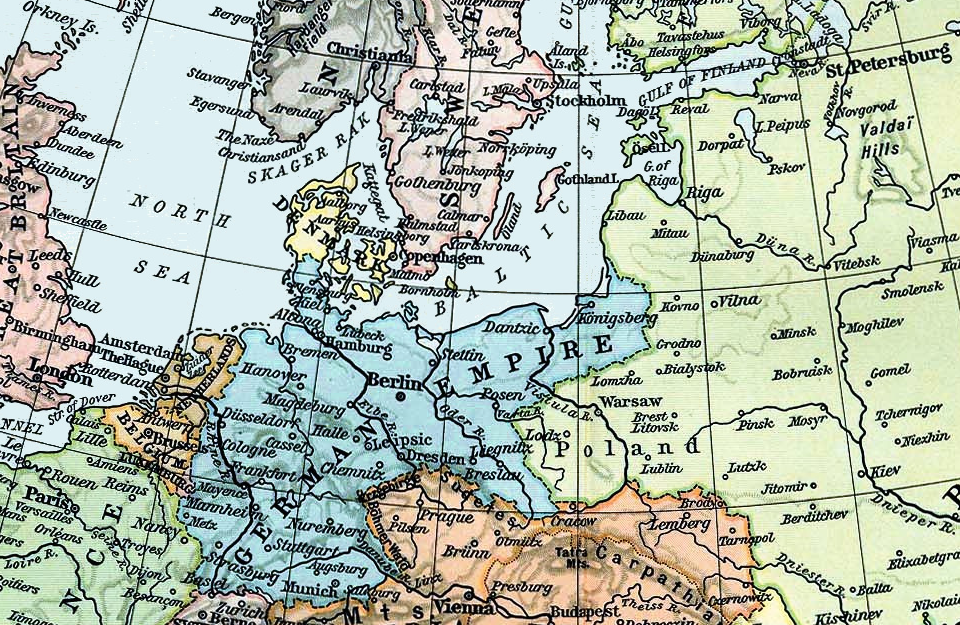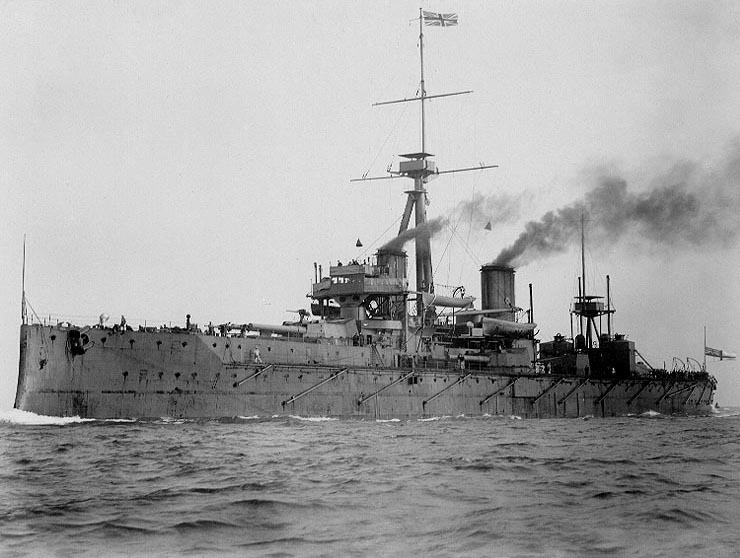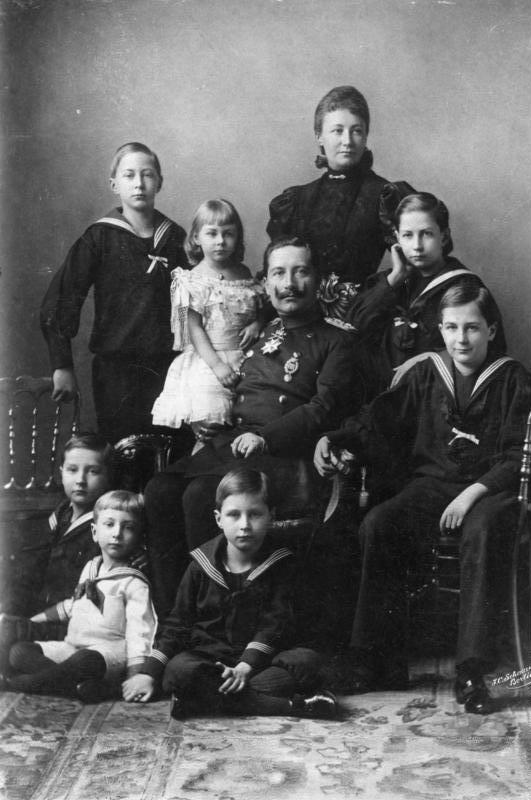|
SMS Wettin
SMS ("His Majesty's Ship ")). was a pre-dreadnought battleship of the of the German (Imperial Navy). She was built by Schichau Seebeckwerft in Danzig. was laid down in October 1899, and was completed October 1902. She and her sister ships—, , and —were the first capital ships built under the Navy Law of 1898. was armed with a main battery of four guns and had a top speed of . saw service in I Squadron of the German fleet for most of her career, along with her sister ships. She was occupied with extensive annual training, as well as making good-will visits to foreign countries. The training exercises provided the framework for the High Seas Fleet's operations during World War I. The ship was decommissioned in June 1911 as dreadnought battleships began to enter service but was reactivated for duty as a gunnery training ship between December 1911 and mid-1914. After the start of World War I in August 1914, the -class ships were mobilized and designated IV Battle ... [...More Info...] [...Related Items...] OR: [Wikipedia] [Google] [Baidu] |
24 Cm SK L/40
The 24 cm Schnelladekanone Länge 40, abbreviated as 24 cm SK L/40, was a German naval gun developed in the years before World War I that armed a number of the Imperial German Navy's pre-dreadnought battleships and armored cruisers. Later guns removed from these ships were converted to coastal artillery and were used during World War I and World War II. The actual bore diameter was , but the classification system for artillery rounded up to the next highest centimeter. History The 24 cm SK L/40 was designed in 1894 and produced in 1898 by Krupp for the Imperial German Navy. Krupp also produced a variant of the 24 cm SK L/40 for the Austro-Hungarian Navy called the 24 cm L/40 K94 which armed coastal defense ships, pre-dreadnought battleships and armored cruisers. Skoda later produced the Škoda 24 cm L/40 K97 and the Škoda 24 cm L/40 K/01 under license. Krupp 24 cm guns also armed coastal defense ships of the Royal Netherlands Navy. Cons ... [...More Info...] [...Related Items...] OR: [Wikipedia] [Google] [Baidu] |
German Empire
The German Empire (), Herbert Tuttle wrote in September 1881 that the term "Reich" does not literally connote an empire as has been commonly assumed by English-speaking people. The term literally denotes an empire – particularly a hereditary empire led by an emperor, although has been used in German to denote the Roman Empire because it had a weak hereditary tradition. In the case of the German Empire, the official name was , which is properly translated as "German Empire" because the official position of head of state in the constitution of the German Empire was officially a " presidency" of a confederation of German states led by the King of Prussia who would assume "the title of German Emperor" as referring to the German people, but was not emperor of Germany as in an emperor of a state. –The German Empire" ''Harper's New Monthly Magazine''. vol. 63, issue 376, pp. 591–603; here p. 593. also referred to as Imperial Germany, the Second Reich, as well as simply Germa ... [...More Info...] [...Related Items...] OR: [Wikipedia] [Google] [Baidu] |
Seiner Majestät Schiff
His (or Her) Majesty's Ship, abbreviated HMS and H.M.S., is the ship prefix used for ships of the navy in some monarchies. Derived terms such as HMAS and equivalents in other languages such as SMS are used. United Kingdom With regard to the separate English and Scottish navies of the medieval period and early modern era, historians usually use terms such as "English Ship" or "Scottish Ship". During the late 17th century, following the Restoration, the name Royal Navy was officially adopted, as well as the prefix His Majesty's Ship, and later, Her Majesty's Ship. The first recorded use of the abbreviated form HMS was in 1789, in respect of HMS ''Phoenix''. From 1707 to circa 1800 HBMS (for ''His Britannic Majesty's Ship'') was also used. Submarines in His Majesty's service also use the prefix HMS, standing for ''His Majesty's Submarine'', though this is sometimes rendered HMS/m. (See, for exampleHMS/m ''Tireless'' at IWM). The Royal Yacht ''Britannia' ... [...More Info...] [...Related Items...] OR: [Wikipedia] [Google] [Baidu] |
Training Ship
A training ship is a ship used to train students as sailors. The term is mostly used to describe ships employed by navies to train future officers. Essentially there are two types: those used for training at sea and old hulks used to house classrooms. The hands-on aspect provided by sail training has also been used as a platform for everything from semesters at sea for undergraduate oceanography and biology students, marine science and physical science for high school students, to character building for at-risk youths. Notable training ships Royal Navy * * * * * * * ''Cornwall'' * * * * * * '' Indefatigable'' * , including adjacent * * * * ''Mount Edgcumbe'' * * * '' Warspite'' (1877) * '' Warspite'' (1922) * * '' Wellesley'' * Other navies * Algerian Navy ** '' El-Mellah'' * Argentine Navy ** ** * Bangladesh Navy ** BNS ''Shaheed Ruhul Amin'' * Brazilian Navy ** ''Cisne Branco'' * Bulgarian Navy ** * Royal Canadian Navy ** (sail training) ** HMCS ... [...More Info...] [...Related Items...] OR: [Wikipedia] [Google] [Baidu] |
Dreadnought Battleship
The dreadnought (alternatively spelled dreadnaught) was the predominant type of battleship in the early 20th century. The first of the kind, the Royal Navy's , had such an impact when launched in 1906 that similar battleships built after her were referred to as "dreadnoughts", and earlier battleships became known as pre-dreadnoughts. Her design had two revolutionary features: an "all-big-gun" armament scheme, with an unprecedented number of heavy-calibre guns, and steam turbine propulsion. As dreadnoughts became a crucial symbol of national power, the arrival of these new warships renewed the Causes of World War I#Arms race, naval arms race between the Anglo–German naval arms race, United Kingdom and Germany. Dreadnought races sprang up around the world, including South American dreadnought race, in South America, lasting up to the beginning of World War I. Successive designs increased rapidly in size and made use of improvements in armament, armour and propulsion throughou ... [...More Info...] [...Related Items...] OR: [Wikipedia] [Google] [Baidu] |
World War I
World War I (28 July 1914 11 November 1918), often abbreviated as WWI, was List of wars and anthropogenic disasters by death toll, one of the deadliest global conflicts in history. Belligerents included much of Europe, the Russian Empire, the United States, and the Ottoman Empire, with fighting occurring throughout Europe, the Middle East, Africa, the Pacific Ocean, Pacific, and parts of Asia. An estimated 9 million soldiers were killed in combat, plus another 23 million wounded, while 5 million civilians died as a result of military action, hunger, and disease. Millions more died in Genocides in history (World War I through World War II), genocides within the Ottoman Empire and in the Spanish flu, 1918 influenza pandemic, which was exacerbated by the movement of combatants during the war. Prior to 1914, the European great powers were divided between the Triple Entente (comprising French Third Republic, France, Russia, and British Empire, Britain) and the Triple A ... [...More Info...] [...Related Items...] OR: [Wikipedia] [Google] [Baidu] |
High Seas Fleet
The High Seas Fleet (''Hochseeflotte'') was the battle fleet of the German Imperial Navy and saw action during the First World War. The formation was created in February 1907, when the Home Fleet (''Heimatflotte'') was renamed as the High Seas Fleet. Admiral Alfred von Tirpitz was the architect of the fleet; he envisioned a force powerful enough to challenge the Royal Navy's predominance. Kaiser Wilhelm II, the German Emperor, championed the fleet as the instrument by which he would seize overseas possessions and make Germany a global power. By concentrating a powerful battle fleet in the North Sea while the Royal Navy was required to disperse its forces around the British Empire, Tirpitz believed Germany could achieve a balance of force that could seriously damage British naval hegemony. This was the heart of Tirpitz's "Risk Theory", which held that Britain would not challenge Germany if the latter's fleet posed such a significant threat to its own. The primary component ... [...More Info...] [...Related Items...] OR: [Wikipedia] [Google] [Baidu] |
I Battle Squadron
The I Battle Squadron was a unit of the German Imperial Navy before and during World War I. Being part of the High Seas Fleet, the squadron saw action throughout the war, including the Battle of Jutland on 31 May – 1 June 1916, where it formed the center of the German line Line most often refers to: * Line (geometry), object with zero thickness and curvature that stretches to infinity * Telephone line, a single-user circuit on a telephone communication system Line, lines, The Line, or LINE may also refer to: Art .... Notes References * * * * See also * Imperial German Navy order of battle (1914) Naval units and formations of Germany in World War I Military units and formations of the Imperial German Navy {{Germany-mil-unit-stub ... [...More Info...] [...Related Items...] OR: [Wikipedia] [Google] [Baidu] |
German Naval Laws
The Naval Laws (german: Flottengesetze, "Fleet Laws") were five separate laws passed by the German Empire, in 1898, 1900, 1906, 1908, and 1912. These acts, championed by Kaiser Wilhelm II and his Secretary of State for the Navy, Grand Admiral Alfred von Tirpitz, committed Germany to building up a navy capable of competing with the Royal Navy of the United Kingdom. German desires and the strategic debate The Kaiser had long wanted a large naval force to assure Germany of what he called " a place in the sun". A large German navy could assist in German attempts to attain colonies, as well as further the country's economic and commercial interests elsewhere in the world. He was determined to make his country a colonial power in Africa and the Pacific. He was also a very militaristic man, and wished to increase the strength of the German armed forces; in particular he wanted to develop a navy that could match the British Royal Navy. As he wrote in his autobiography: Though Wilh ... [...More Info...] [...Related Items...] OR: [Wikipedia] [Google] [Baidu] |
Capital Ship
The capital ships of a navy are its most important warships; they are generally the larger ships when compared to other warships in their respective fleet. A capital ship is generally a leading or a primary ship in a naval fleet. Strategic implications There is usually no formal criterion for the classification, but it is a useful concept in naval strategy; for example, it permits comparisons between relative naval strengths in a theatre of operations without the need for considering specific details of tonnage or gun diameters. A notable example of this is the Mahanian doctrine, which was applied in the planning of the defence of Singapore in World War II, where the Royal Navy had to decide the allocation of its battleships and battlecruisers between the Atlantic and Pacific theatres. The Mahanian doctrine was also applied by the Imperial Japanese Navy, leading to its preventive move to attack Pearl Harbor and the battleships of the U.S. Pacific Fleet. The naval nature ... [...More Info...] [...Related Items...] OR: [Wikipedia] [Google] [Baidu] |
Sister Ship
A sister ship is a ship of the same class or of virtually identical design to another ship. Such vessels share a nearly identical hull and superstructure layout, similar size, and roughly comparable features and equipment. They often share a common naming theme, either being named after the same type of thing or person (places, constellations, heads of state) or with some kind of alliteration. Typically the ship class is named for the first ship of that class. Often, sisters become more differentiated during their service as their equipment (in the case of naval vessels, their armament) are separately altered. For instance, the U.S. warships , , , and are all sister ships, each being an . Perhaps the most famous sister ships were the White Star Line's s, consisting of , and . As with some other liners, the sisters worked as running mates. Other sister ships include the Royal Caribbean International's and . ''Half-sister'' refers to a ship of the same class but with som ... [...More Info...] [...Related Items...] OR: [Wikipedia] [Google] [Baidu] |
Keel Laying
Laying the keel or laying down is the formal recognition of the start of a ship's construction. It is often marked with a ceremony attended by dignitaries from the shipbuilding company and the ultimate owners of the ship. Keel laying is one of the four specially celebrated events in the life of a ship; the others are launching, commissioning and decommissioning. In earlier times, the event recognized as the keel laying was the initial placement of the central timber making up the backbone of a vessel, called the keel. As steel ships replaced wooden ones, the central timber gave way to a central steel beam. Modern ships are most commonly built in a series of pre-fabricated, complete hull sections rather than around a single keel. The event recognized as the keel laying is the first joining of modular components, or the lowering of the first module into place in the building dock. It is now often called "keel authentication", and is the ceremonial beginning of the ship's li ... [...More Info...] [...Related Items...] OR: [Wikipedia] [Google] [Baidu] |

.jpg)





